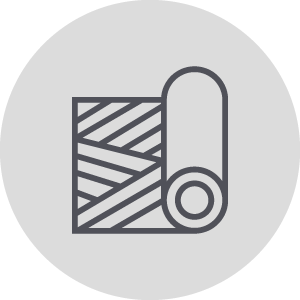Before a liquid floor screed or underfloor heating installation, the area must be prepared exactly to our specifications. Following our work, floor screeding has to be sufficiently dried and prepared before the installation of coverings or units. Failure to comply with our guidance may cause a delay in the installation or a fault later down the line.
We have prepared guides below to assist you in every step of your refurbishment from the floor insulation to the time you can lay a floor covering. If you have any further questions, call us on 01743 343000 or email sales@easyflow.org.uk.
If you are hiring EasyFlow for the pouring of liquid floor screed only, follow the steps provided. Be sure you know the exact depth of floor screeding and floor insulation required before you start.

Remove ALL dust and debris from the floor surface, as these can impact the floor insulation efficiency. Provide an external washout area for cleaning the pump and a lined skip or enclosed rubble pile to dispose of excess material.

Place floor insulation, ensuring ALL high/low points are removed from the sub-base so that the boards are laid flat. If they are not flat, this can cause the floor screeding to be thinner in uneven areas.

A polythene separating membrane is required with all liquid floor screeds. Lay the polythene, ensuring that it is free from punctures and creases and that it continues up the walls to the full depth of the screed. Overlap joints, make sure the polythene fits tightly into the corners, then seal with duct tape to avoid leakages and secure corners.

Place 5-10mm thick expansion foam around the perimeter in all rooms using tape to secure it to the polythene. If you are not undertaking an underfloor heating installation, the floor is now ready for the EasyFlow team to pour liquid floor screed.

Skip this step if you are using a tray system. All pipes need to be clipped securely, piercing the insulation. Use self-sealing clips, so they will not leak when the floor screeding is poured. Underfloor heating installations should be pressure tested prior to the pour to reduce the risk of the pipes floating in the screed.

Skip this step if you are using a clipped system. Ensure you have expansion strips for the trays. Plumbers' merchants usually supply a polystyrene-backed cardboard expansion strip with the trays.
Following installation, the environment must remain sealed for 2 days. The screed should be protected from sunlight & frost during this time. Do not cover the floor screeding with polythene or plywood boards.
Storage of materials on the screed surface, accidental exposure to water, humid or cold environments, will delay drying. Anhydrite screeds like Gyvlon will produce a powdery substance called laitance as it dries, which should be removed after 7 days of drying.
When poured over an underfloor heating installation, the screed must be heated before the application of floor finishes. This can commence 7 days after installation. Heating should be gradual in 3-5°C increments. At no time should the temperature exceed 50°C.
For tiled underfloor heating, a 3 week cycle is recommended before tiling; 7 days running up to temperature, 7 days at your operating temperature and 7 days cooling down. This will help condition the screed to movement without the floor covering in place.
Heating should not be switched back on again for a further 14 days after tiling over the underfloor heating installation, it can then be brought up to the operating temperature gradually.
It is essential that the floor screed is fully dry before you apply a floor finish or install units over the screed. Prior to floor coverings, the screed must be tested and the moisture content must be below 75% RH (0.5% Moisture).
Most liquid floor screeds will dry at a rate of 1mm per day for a thickness of up to 40mm and then at 0.5mm per day for anything over 40mm. Fast drying screed can dry at a rate of up to 10-15mm per day if conditions are optimal.
When applying adhesives or cement-based products, the screed surface MUST be primed with an acrylic primer, or as recommended by the manufacturer. An anhydrite screed will produce laitance, and this must be sanded to ensure that any adhesives bond to the anhydrite screed.
EasyFlow are here to support you at every step after we have poured your screed. We offer sanding and moisture testing services to ensure your floor is ready to receive its final finish. Simply contact us by phone or email to discuss your requirements.

Where To Find Us